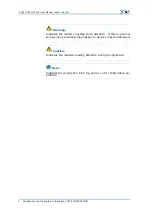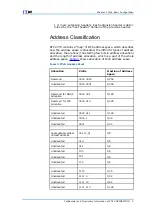
Chapter 2 IPv6 Basic Configuration
In the IPv6 addressing system structure, any IPv6 unicast ad-
dress requires an interface identifier. An interface identifier
is very similar to the 48-bit Media Access Control (
) ad-
dress. The MAC addresses are encoded through hardware in a
network interface card. They are burned by the manufacturer
into a network interface card and are globally unique. There
are no two network interface cards with an identical MAC ad-
dress. Such addresses can be used to uniquely identify the
interfaces at the network link-layer.
The interface identifier of an IPv6 host address is based on
the IEEE EUI-64 format, which creates a locally and globally
unique 64-bit interface identifier based on the existing MAC
addresses. The appendix attached to the RFC 2373 describes
how to create interface identifiers.
These 64-bit interface identifiers can address one by one glob-
ally and can uniquely identify the interface of each network.
This means that, in theory, there are up to 264 different physi-
cal interfaces and about 1.8 x 1019 different addresses, which,
however, only occupy half of the IPv6 address space.
It is
enough in the foreseeable future at least.
The IPv6 unicast address can be classified into the following
categories:
�
Aggregatable Global Unicast Address
This is another kind of aggregation, which is independent of
Internet Service Provider (
). The provider-based aggre-
gatetive addresses must be changed as a provider changes,
while the exchange-based addresses are directly located by
an IPv6 switching entity. The exchange provides address
blocks, and users and providers conclude contracts for the
network access.
Such network access is either directly provided by a
provider, or indirectly provided by an exchange. However,
the routing is through the exchange. In this way, a user
needs not to address again when it changes a provider. At
the same time, users are allowed to use multiple ISPs to
process single-block network address.
Aggregatable global unicast addresses include all the ad-
dresses whose three starting bits are 001, which can be
used as prefixes for other unallocated unicast. Format the
addresses into the fields as shown in
.
T
ABLE
4
AGGREGATABLE
G
LOBAL
U
NICAST
A
DDRESS
F
IELDS
3
13
8
24
16
64
FP
TLA
ID
RES
NLA
ID
SIA
ID
Interface identifier
The table includes the following fields.
–
FP field
This is the 3-bit format prefix in an IPv6 address, in-
dicating to which address category in the IPv6 address
space this address belongs. Currently, the field is 001,
Confidential and Proprietary Information of ZTE CORPORATION
7
Содержание ZXR10 T1200
Страница 5: ...Figures 71 Tables 73 List of Glossary 75 ...
Страница 6: ......
















































